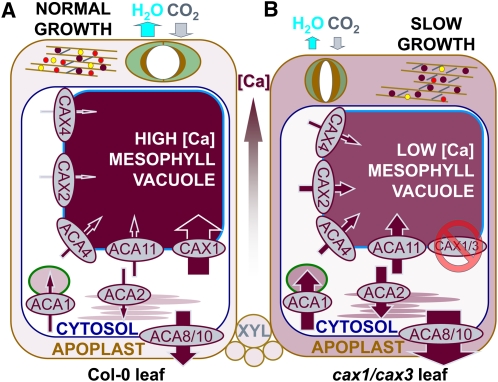Figure 6.
Proposed Model for Control of [Ca2+]apo in Col-0 and Consequences of a Perturbed Ability to Secrete Ca2+ from the Apoplast into Mesophyll Vacuoles in cax1/cax3.
Size of arrows indicates proposed flux through transporters as extrapolated from transcript abundance and phenotypes of plants.
(A) In Col-0, free [Ca2+]apo is maintained at a low enough concentration so as not to close stomata; gas exchange rates are high, and growth rate is normal.
(B) When CAX1 and CAX3 are not present on the tonoplast and mesophyll cells, the transcription of other tonoplast transporters (ACA11, CAX2, and CAX4) increases, but the ability to accumulate as high [Ca]vac is compromised. As a result, (1) stomatal apertures and gas exchange decrease; (2) transcription of nontonoplast transporters increases, potentially increasing the Ca2+ flux into, and [Ca] within, the chloroplast/plastid (ACA1), ER (ACA2), and apoplast (ACA8 and ACA10); (3) cell wall components and xyloglucan (gray lines) increase between cellulose microfibrils, resulting in a thicker cell walls. In addition, Ca-pectate (purple circles) and PME increase and PGA (yellow circles) and expansins (red circles) decrease, resulting in less extensible cell walls and smaller cells. [K] increases in cax1/cax3 vacuoles to compensate for the reduction in [Ca2+] at the expense of epidermal [K+]vac through an unknown mechanism.

